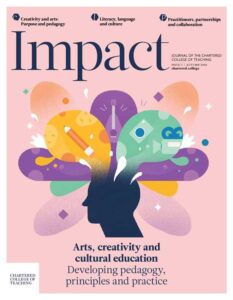Digital Methods for the English Classroom

This article introduces a free linguistic tool (developed in a collaborative project between University of Birmingham and the University of Nottingham and funded by an Arts and Humanities Research Council grant reference AH/P504634/1), with suggestions for how it can be used in English classes to integrate the study of language and literature.
It is commonplace for English teachers to come from a literature background (Myhill and Watson, 2014) and there is a shortage of applicants to the profession from a linguistics background (Blake and Shortis, 2010; Clark and Macrae, 2014). At the same time, specifications like the AQA English language and literature A-level (AQA, 2018) now look for both integrated linguistic and literary study, and exploration of connections across texts, informed by linguistic and literary concepts.
We have developed the CLiC web app as a tool to allow teachers to easily integrate linguistic activities into their literature classes. CLiC (http://clic.bham.ac.uk) provides access to over 140 nineteenth-century texts online. The web app makes it possible to search for words and phrases within individual novels and across texts by different authors. CLiC has multiple applications for GCSE English literature, where students need to be able to present an in-depth analysis of themes and characters in nineteenth-century novels that stretches beyond simply ‘knowing’ about a text (see Howard, 2018). A-level English literature necessitates that students provide articulate, informed, personal and creative responses and have a strong understanding of the structures of texts (AQA, 2019). For both qualifications, the search functionalities of CLiC can support the close reading of texts, help students identify key quotations, as well as links between textual extracts across a whole book, and find lexical signals of textual structures.
Feedback from teachers we have worked with suggests that the tool can be useful for ‘stretch and challenge purposes’, revision and lesson planning. The tool seems most helpful when teachers can customise activities for their own teaching. Developing these activities requires a certain familiarity with the tool, so we have created a free introductory activity book to get teachers started (Mahlberg et al., 2017). In this article, we show examples of the types of activities that you can do in the classroom. One type of activity is to trace occurrences of words across the texts. This allows students to draw conclusions about the structure of the text and the importance of word choices for themes in the text, so that they can notice these for purposeful repetition. Such activities can be easily adapted for non-exam assessment (NEA) and, most importantly, provide a new and engaging way for students to explore literature.
CLiC in the classroom: Tracing occurrences across an individual text
English teachers will be familiar with GCSE exam questions that present students with a text extract to analyse and require them (AO1) to show their knowledge about the wider textual context, supported by appropriate quotations (AQA, 2014). Adriano (2018) demonstrates that CLiC can support the process of whole-text exploration as discovery learningAllowing learners to discover key ideas or concepts for them... More. She asked her Year 10 class to use CLiC in order to trace the singular and plural forms of ‘door’ across The Strange Case of Dr Jekyll and Mr Hyde. She reports that students not only ‘enjoyed being able to access evidence with ease and speed’, but were also able to draw wider conclusions about their findings: ‘[t]he number of references to doors convinced them that Stevenson had made deliberate choices’ (Adriano, 2018). With the help of digital technology, students can explore the text in a new way that helps them to become more aware of textual connections. In turn, this can help them not only to remember quotations but also to use them in a more meaningful way.
Here, we illustrate the exploratory approach with an example of a classroom activity for A Christmas Carol. The activity begins by asking students to read the extract from Stave I that starts with ‘Oh! But he was a tight-fisted hand at the grind-stone, Scrooge!’ and ends with ‘No eye at all is better than an evil eye, dark master!’ When students read this extract, they will see how Scrooge is described as a cold character: ‘The cold within him froze his old features’. The text suggests that Scrooge will not change. The external world has little influence on him (‘No warmth could warm, no wintry weather chill him’). Students will especially notice the repetition of the related forms ‘warmth’ and ‘warm’. The repetition draws attention to the contrast between warmth and cold (‘cold’, ‘wintry weather’) that is described.
The extract gives a striking description of Scrooge before he goes through his transformation. From the extract, we can ‘zoom out’ to a wider perspective. The word ‘warm’ is a starting point for this bigger picture. CLiC finds all instances of the adjective ‘warm’, the comparative adjective ‘warmer’ and the verb forms ‘warm’ and ‘warming’, as well as the noun ‘warmth’. It displays these instances in a format called a ‘concordance’ (see Figure 1).
The metaphor of temperature in the initial text extract illustrates the contrast between isolation and family (or friendship). This contrast can be traced throughout the whole text with the help of the concordance. The first occurrence of ‘warmth’ (Figure 1, line 1: ‘No warmth could warm’) is from our initial text extract and refers to Scrooge. By contrast, Christmas gatherings are characterised by their warmth and happiness, such as the example from line 11 in Figure 1. Through the concordance, students can explore how contrasts between isolation/cold and family and friendship/warmth are built up throughout the text.
| 1 | d had little influence on Scrooge. No | warmth | could warm, no wintry weather chill him |
| 2 | e influence on Scrooge. No warmth could | warm, | no wintry weather chill him. No wind th |
| 3 | their feet upon the pavement stones to | warm | them. The city clocks had only just gon |
| 4 | ut on his white comforter, and tried to | warm | himself at the candle; in which effort, |
| 5 | on the clerk, who, cold as he was, was | warmer | than Scrooge; for he returned them |
| 6 | Poor some meat and drink, and means of | warmth. | We choose this time, because it is a |
| 7 | y of ragged men and boys were gathered: | warming | their hands and winking their eyes |
| 8 | he could extract the least sensation of | warmth | from such a handful of fuel. The |
| 9 | ndage round its head, as if it were too | warm | to wear indoors, its lower jaw dropped |
| 10 | ed to pedestrian purposes; that bed was | warm, | and the thermometer a long way below |
| 11 | ire; and the warehouse was as snug, and | warm, | and dry, and bright a ball-room, as you |
| 12 | wn before the fire, my dear, and have a | warm, | Lord bless ye!”¶ “No, no! There’s |
| 13 | n, generous, and true; the heart brave, | warm, | and tender; and the pulse a man’s. |
Figure 1: Concordance lines of ‘warm*’ in A Christmas Carol
In a similar activity, Howard (2018) traces occurrences of the word ‘time’ across A Christmas Carol using CLiC. She argues that ‘[p]laced chronologically, the utilisation of the word demonstrates the shift in Scrooge’s understanding of time itself’ (Howard, 2018). So, going through concordance lines of ‘time’, students can observe how, as Scrooge meets the ghosts, his perception changes from a strictly ‘monetary value’ to a ‘gift’. This active engagement with the texts allows students to gain a sense of how extracts are connected and contextualised, contributing to an overall theme.
CLiC as a tool for lesson planning
As we seek useful text extracts to exemplify themes and provide illustration of linguistic devices during lesson planning, we can use CLiC to find examples for our lessons. Line 5 from the concordance above (Figure 1) comes from the following passage:
(1) His nephew left the room without an angry word, notwithstanding. He stopped at the outer door to bestow the greetings of the season on the clerk, who, cold as he was, was warmer than Scrooge; for he returned them cordially.
A Christmas Carol, Stave I
In this extract, Scrooge’s nephew Fred has just left the office, having been unsuccessful in inviting Scrooge to his Christmas dinner. While the example describes the clerk as cold (previously we have learned that, due to Scrooge’s austerity, the office is only heated to a minimum), the clerk is still described as ‘warmer than Scrooge’. This warmth refers to the clerk’s kindness in returning the season’s greetings.
To further explore the development of the story and identify particular passages for the classroom, teachers can use the ‘distribution plot view’. This view will display any search results across the book as represented by a horizontal line, so that the storyline can be traced and quotations can be contextualised according to where in the text they occur.
CLiC for students’ independent work: Revision and NEA
The fact that the most recent GCSE exams are closed book yet students are tasked with using ‘textual references, including quotations’ (AQA, 2014) has become a contentious issue for many teachers. CLiC can help students to engage with whole texts and encourage independent learning when it comes to selecting, remembering and making links between quotations. In this sense, CLiC can help students to make the best use of their revision time. Instead of ‘quote cramming’, students can use the CLiC search functions to purposefully ‘engage with meaning’ (Kemp, 2018).
One way of engaging with the use of a particular word across a text is to categorise the individual mentions. Kemp (2018) outlines this approach in a CLiC revision activity for Frankenstein. Students are asked to run a simple search for ‘creature’ in Frankenstein. They then ‘tag’ the lines to answer questions such as who or what the word creature refers to and what connotations it has at different stages of the novel.
Another strategy for revision is to start the CLiC search with a key quotation and then link it to the wider text. Example (2) shows how the Ghost of Christmas Present asks Scrooge a significant question.
(2) ‘Are there no prisons?’ said the Spirit, turning on him for the last time with his own words. ‘Are there no workhouses?’
A Christmas Carol, Stave III
Using CLiC, we find that the word ‘workhouses’ only occurs twice in A Christmas Carol. Earlier in the text, Scrooge himself uses the word in a very similar question, when he responds to the men who approach him to raise funds for the poor, as illustrated in (3).
(3) ‘And the Union workhouses?’ demanded Scrooge.
‘Are they still in operation?’
A Christmas Carol, Stave I
The narrator’s description in (2), ‘turning on him for the last time with his own words’, indicates that the spirit echoes Scrooge’s own rhetorical question. This reference to Stave I reveals what a heartless attitude Scrooge held before the spirits visited him. The relevance of these key quotations is illustrated in an exemplar exam for Edexcel (Pearson Education, 2014).
These quotations also provide a good starting point for exploring the social context. For instance, students can use CLiC to search for ‘workhouse*’, to find both singular and plural instances in all of Dickens’s novels. The search reveals a wide range of descriptions of workhouses, depicting the harsh living and working environments for both adults and children.
The independent learning that is enabled by the CLiC web app makes it a useful tool for the NEA at A-level. Linguistic analysis of literary texts is clearly one of the crucial elements of the A-level language/literature specifications, and CLiC has applications for the literature NEA too. For example, if students want to compare and contrast the representation of the working class in North and South and Hard Times, they can run concordances for thematic words in both novels, such as ‘factory’, ‘mill’, ‘work*’ (finding compounds like ‘workpeople’ and ‘workhouses’), ‘the hands’ (meaning factory workers) and ‘town’. As with the examples above, students can use these concordances to identify important passages for more detailed study. The concordance lines will alert students to additional words that they can study. The NEA example illustrates how technology – such as using CLiC to search for words – does not provide a full answer. CLiC facilitates an investigation into the text that needs to be complemented with further, more traditional analysis. It is an example of a new and freely available tool that can be employed in a pedagogically useful way (also see the January 2019 issue of Impact on education technology).
Conclusions
Our brief examples have illustrated how CLiC helps to visualise vocabulary patterns as well as the development of the text through the concordance view. This use of technology can help students turn the analysis of a text into a discovery learning activity. It aids students’ understanding and it can also be used to refresh their memory for retaining knowledge of the plot, themes and key quotations.
CLiC is a collaborative research project between the University of Birmingham and the University of Nottingham (Arts and Humanities Research Council grant reference AH/P504634/1).
References
Adriano L (2018) CLiC in the Classroom. In: CLiC Fiction. Available at: https://blog.bham.ac.uk/clic-dickens/2018/03/05/clic-in-the-classroom (accessed 23 July 2019).
AQA (2014) GCSE English literature (version 1.1). Available at:
https://filestore.aqa.org.uk/resources/english/specifications/AQA-8702-SP-2015.PDF
(accessed 14 June 2019).
AQA (2018) AS and A-level English language and literature (version 1.3). Available at: https://filestore.aqa.org.uk/resources/english/specifications/AQA-7706-7707-SP-2015.PDF (accessed 14 June 2019).
AQA (2019) AS and A-level English literature A (version 1.2). Available at: https://filestore.aqa.org.uk/resources/english/specifications/AQA-7711-7712-SP-2015.PDF (accessed 14 June 2019).
Blake J and Shortis T (2010) The readiness is all: The degree level qualifications and preparedness of initial teacher trainees in English. English in Education 44(2): 89–109.
Clark B and Macrae A (2014). Lang-Lit from A to BA: Integrating Language and Literature Study at School and University. York: Higher Education Academy.
Howard K (2018) What’s in a word: Exam-ready with CLiC. In: CLiC Fiction. Available at: https://blog.bham.ac.uk/clic-dickens/2018/03/27/whats-in-a-word-exam-ready-with-clic (accessed 17 July 2019).
Kemp B (2018) Revising Frankenstein with CLiC Dickens. In: CLiC Fiction. Available at: https://blog.bham.ac.uk/clic-dickens/2018/04/05/revising-frankenstein-with-clic-dickens (accessed 17 July 2019).
Mahlberg M, Stockwell P and Wiegand V (2017). CLiC – Corpus Linguistics in Context: An Activity Book, version 1. Available at: http://birmingham.ac.uk/clic-activity-book (accessed 14 June 2019).
Myhill D and Watson A (2014) The role of grammar in the writing curriculum: A review of the literature. Child Language Teaching and Therapy 30(1): 41–62.
Pearson Education (2014) Pearson Edexcel Level 1/Level 2 GCSE (9–1) in English literature sample assessment materials – issue 1. Available at: https://qualifications.pearson.com/content/dam/pdf/GCSE/English%20Literature/2015/teaching-and-learning-materials/christmas-carol-exemplars-1512.pdf (accessed 14 June 2019).










